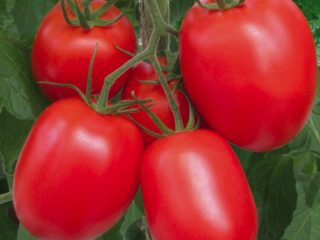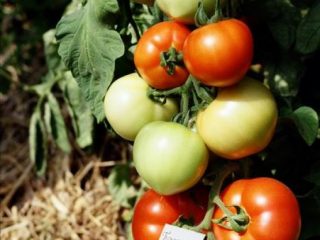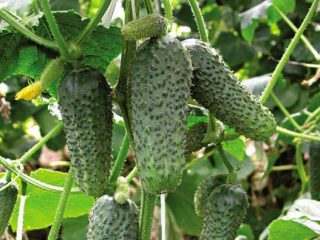Content
Tomato flowers fall off - this is one of the common complaints of gardeners. The owner of the crop is faced with the task of not only eliminating this unpleasant phenomenon, but also finding out the cause. If you deal with the problem in a timely manner, it is possible to save the future harvest, despite some of the lost ovaries and flowers.
Why do the flowers and ovaries of tomatoes fall off?
The reasons for the fall of flowers in tomatoes can be both objective and subjective. Both unfavorable weather conditions and careless actions of gardeners can harm the plant. Depending on the factor that caused the flowers to fall off, it is important to adhere to a specific treatment plan.
Improper watering
Often, tomato owners, seeing buds falling off or leaves withering, begin to moisten the soil abundantly, believing that the reason is a lack of moisture. But excessive watering only aggravates the situation: in such an environment, bacteria and fungi become active, destroying the roots.
With poor watering, tomato flowers in a greenhouse dry out from a lack of nutrients coming from the soil along with water.
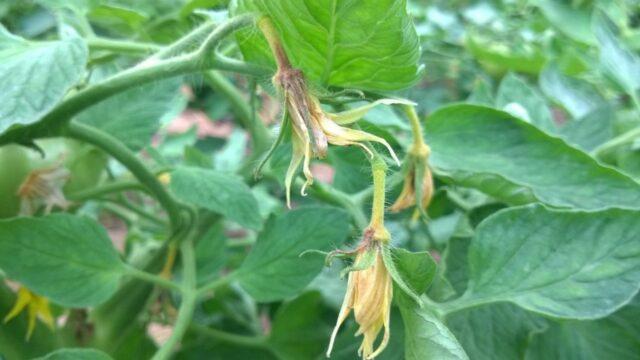
With a lack of moisture, the first sign is yellowing of the pedicels, which then dry out and fall off
High air humidity
More often, gardeners who grow tomatoes in greenhouses face this problem. In an effort to create ideal conditions, they humidify the air. And if this figure is above 70%, then the plant begins to lose flowers.
It should be borne in mind that there are varieties that tolerate drought or excess moisture well, but over time even they suffer from the created conditions.
Poor seed quality
You should purchase material only from trusted stores. Some gardeners collect seeds themselves, violating the harvesting and storage technology. They also do not take into account the fact that some varieties are hybrids that cannot be used for propagation. It is because of defective seeds that the ovary on tomatoes falls off.
Lack of sunlight
Sun deficiency negatively affects tomatoes, in which photosynthesis processes begin to be disrupted. With a lack of light, the buds on the bush fall off. There are shade-tolerant varieties, but they also need sufficient lighting for greater yield.
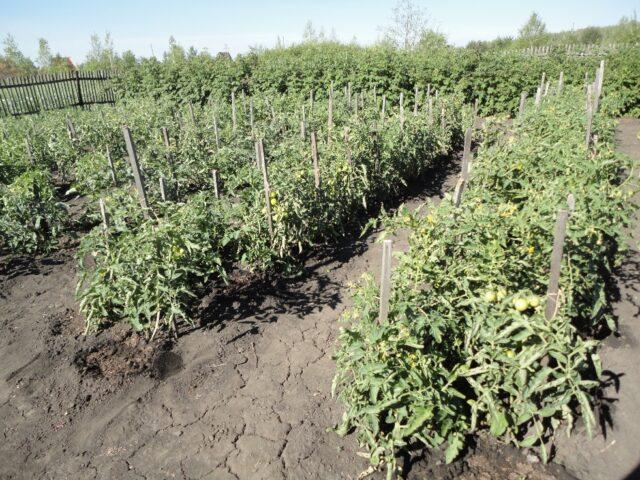
When planting tomatoes on a plot, you should always plan the beds so that all plants have enough sunlight
Temperature changes
And although tomatoes love high temperatures, heat is not good for them. If the air in the greenhouse warms up above +35 °C, then the pollen becomes sterile. It is because of this that the flowers fall off along with the stalk.
This conclusion was made by breeders after they noticed that bushes planted near aisles or entrances bear fruit more abundantly.
In consistently hot weather, gardeners can save the plants by covering the greenhouses on the south side with non-woven material. To increase the intensity of pollination and prevent flowers from falling, it is recommended to lightly shake the bushes in the morning.
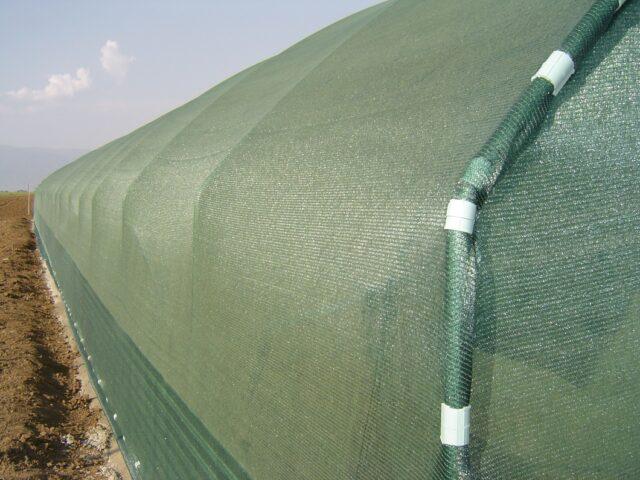
In order to save tomatoes from scorching rays and falling buds, you can use shading, breathable nets
Tomato flowers are drying up in the greenhouse due to the cold weather. If the temperature drops below +15 °C, then all processes in tomatoes slow down and flowers fall off. To solve the problem, gardeners water the beds with warm water, install heaters, and build stoves. The falling of buds stops as soon as the plant recovers.
In open ground, you can protect bushes using agrofibre or other available materials.
Planting density
The desire to get more vegetables from one bed leads to the fact that the gardener violates the rules of agricultural technology by placing tomatoes at a close distance.
As a result of such actions, there is little space for the plant root system, and the above-ground part of the tomatoes does not have enough sunlight. It should be borne in mind that during the rainy season, a lot of moisture accumulates in thickened plantings, which is why harmful microorganisms actively multiply. Due to lack of nutrition and light, the flowers of tomatoes fall off and break off.
Lack or excess of fertilizers
Fertilizers should be used in a timely manner and strictly according to the instructions.With an excess of nitrogen, tomato bushes increase their green mass, shading each other. Yellowing and falling of the stalks indicates a lack of phosphorus and potassium. If you add the missing substances to the soil in time, you can save the crop.
If the soil has a high acidity pH of more than 6.5, then boron and manganese are less absorbed by tomatoes. In this case, brown spots appear on the sepals, and then you can notice the flowers falling off.
Diseases and pests
As a result of the activity of insects and microorganisms, both the root system and the above-ground part of tomatoes can be damaged. Flowers fall off due to lack of nutrients and weakening of plants.
Mole crickets often attack the roots of tomatoes. Digging tunnels, they destroy everything in their path. They are active in beds richly fertilized with manure.
To combat insects and prevent flowers from falling, it is recommended to regularly loosen the beds, use mineral fertilizers, as well as special compounds.
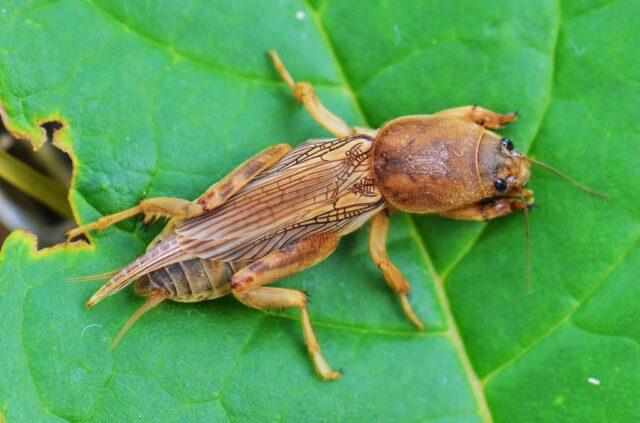
A popular drug for killing mole crickets is Borevin.
The real horror of gardeners is the wireworm. It is almost impossible to remove it from the site in one season. This insect, reminiscent of a small centipede, not only destroys the roots, but also the stems of tomatoes, loves root vegetables, survives severe frosts well and multiplies quickly.
To destroy wireworms, a combination of physical methods and chemical agents is necessary. Gardeners dig up plots several times a season and destroy the pest when caught. Among the drugs, the use of the insecticide Bazudin is common.
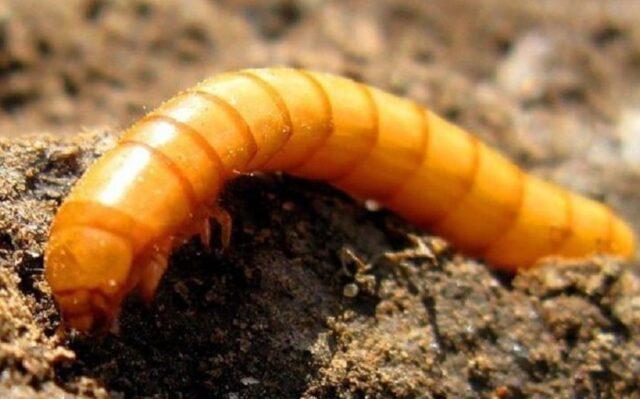
If no measures are taken, the wireworm successfully destroys entire crop plantations
In dense plantings you can often encounter fungal activity. It thrives in moist soil and covers the soil surface with a white coating. Gradually it spreads throughout the plant. This is manifested not only by falling flowers, but also by wilting of leaves and slower growth of the tomato. If you do not use fungicides, it will successfully destroy the plant.
What to do if flowers fall off on tomatoes in the greenhouse and in the open ground
When growing tomatoes under cover, it is necessary to provide comfortable conditions for the plant in the room. Control humidity levels, air temperatures, and lighting levels. Many parameters can be adjusted: the greenhouse can be ventilated, phytolamps can be installed in it, and it can be heated with a stove.
Separately, it is necessary to specify the watering rules:
- Tomatoes should only be moistened in the evening to prevent buds from falling off.
- Water should be used that has settled and warm. To do this, it is collected in containers and left in barrels for 24 hours. During this period, not only will less-useful plumbing substances evaporate from it, but a comfortable temperature will also be established. There is no need to water the tomatoes from above. This can not only lead to flowers falling off, but also rot.
The most common fertilizer for tomatoes to prevent flowers from falling off is mullein infusion. After all, this substance contains not only nitrogen, but also phosphorus and potassium, which are necessary for the full formation of ovaries.
If it is not possible to prepare an infusion, then gardeners water the tomato beds with green tea. To do this, pour a glass of the dry mixture with a bucket of water and leave for 2-3 days. This remedy is great for preventing buds from falling off.
If signs of pests or diseases appear, it is recommended to treat the shrubs with chemicals according to the instructions and reconsider your principles of caring for the plant.
Preventive measures
To prevent flowers from falling off tomatoes, you should follow certain rules:
- Compliance with the irrigation regime taking into account the climatic characteristics of the region.
- Use only proven certified seeds for planting in licensed stores.
- Maximize the temperature conditions in open ground and greenhouses using improvised means. Do not neglect ventilation, heating, shading to prevent flowers from falling off.
- Protect bushes from heavy winds. Indeed, in this case, the falling of flowers occurs under mechanical influence.
- Carry out pollination yourself using a brush or brush.
- Avoid thickening of plantings, form plants in a timely manner, and provide them with support.
In most cases, it is enough to adjust the growing conditions to stop the falling of flowers, therefore, when planting varieties, you should study the climatic features of the region and calculate possible risks.
Conclusion
Tomato flowers fall off for those gardeners who have encountered problems growing the crop. Despite the assurances of manufacturers, any varieties require full care. Only by following the principles of agricultural technology is it possible to obtain a bountiful harvest. But even if a problem with flowers falling off is discovered, you should not refuse to save the plant: with the right approach, it is possible to preserve the remaining ovaries.

